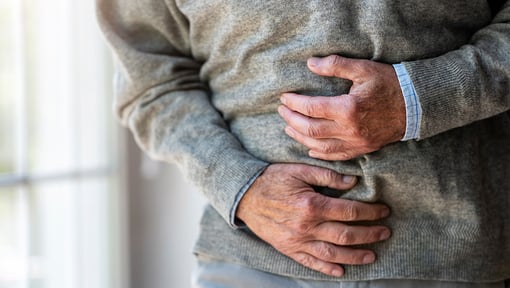If digestive woes plague you after every meal, certain foods or ingredients may be to blame. An elimination diet can help you pinpoint which ones.
Every now and then, it’s common to have a bit of discomfort after eating. Bloating. Gas. Diarrhea. It certainly isn’t fun. But having these digestive troubles once in a while is pretty normal.
You may find, though, that this sort of thing happens more often than not. Or it might feel very uncomfortable or even painful. It might make you feel embarrassed or self-conscious—or start to disrupt your life. If so, that’s not normal. You might have an issue with a certain ingredient, food, or food group. Talking with your doctor about doing an elimination diet may be a good next step.
When you do an elimination diet, you stop eating certain foods or even whole food groups for a short period of time. During that time, you monitor your symptoms to see if they get better or go away altogether. Then you add each food or food group you eliminated back into your diet, one at a time, to see if your symptoms return. This can help you figure out which foods, if any, might be causing your symptoms.

The goal of an elimination diet
An elimination diet is not about weight loss or weight management. You might wind up losing some weight while you’re following it. But that’s not the goal. The goal is to see if you have a food allergy or a food intolerance.
A food allergy occurs when your immune system overreacts to a certain food. Food allergies can be very serious—even life-threatening. Symptoms can vary. You may experience swelling of your face, lips, or throat. You might have sneezing, stuffy nose, and watery eyes. Or you may develop a rash or hives on your skin. Vomiting, stomach cramps, and/or diarrhea may also occur. Learn about the 8 most common food allergens here.
A food intolerance or a food sensitivity is slightly different. It occurs when your digestive system can’t break down a certain ingredient or chemical in a food. You might lack a certain enzyme needed to do this. Or you might not have the proper balance of bacteria in your gut. Either problem can make it hard for you to digest certain foods.
Common symptoms of a food intolerance or a food sensitivity include gas, bloating, and diarrhea. But you might also feel tired, have joint or muscle pain, or get headaches. Learn about the most common causes of food intolerance.
An elimination diet isn’t the only tool that can help diagnose food-related issues. For instance, there are some tests—like a skin prick test and a blood test—that can help pinpoint a food allergy. And if you or your doctor suspect you might have a serious food allergy, those tests might be better—and safer—than an elimination diet. But an elimination diet is another tool that can help determine if you have a less serious problem with a particular food.

Some surprising side benefits to expect from an elimination diet
An elimination diet may also help pave the road to healthier eating in a couple of different ways. It forces you to read the ingredient labels on packaged foods more often and more carefully. Getting into this habit can increase your awareness of just how much added sugar, sodium, and artificial ingredients are in many packaged foods. This in turn may motivate you to shift away from eating a lot of highly processed foods and toward eating more nutritious whole foods instead.
An elimination diet may also force you to eat out less often. That’s because asking your food server which ingredients the chef uses in every item on the menu is not realistic. Research has shown that eating out less and at home more tends to lead to healthier eating habits. It can also save you money.

The importance of working with a medical expert
If you try an elimination diet, you’ll want to work with a medical expert. That might be your doctor. Or your doctor might recommend a specialist, such as a:
- Gastroenterologist
- Allergist
- Registered Dietitian Nutritionist (RDN)
The best place to start is with your doctor. They can rule out any health conditions that might be causing your symptoms. This might include celiac disease or an inflammatory bowel disease, like Crohn’s disease. Plus, they might want to test you for food allergies. But, if they think it would help, your doctor may suggest an elimination diet.
Having medical guidance and supervision while you are following an elimination diet is vital. An expert can help:
- Advise you on the type of elimination diet that’s best for you. If your symptoms are fairly mild, a less intensive diet might work well for you. But if you have more serious symptoms, then an intensive elimination diet might be the best choice.
- Determine which foods to eliminate from your diet. You might not know where to start—or which foods or food groups are the most likely culprits. A health care expert can help figure that out. They might consider your symptoms and other factors, like your health history and family history. They might even order tests to help guide their decision.
- Monitor your diet to make sure you’re getting the vital nutrients you need. You might wind up cutting out a whole food group or food groups for a period of time. That means you won’t be getting the nutrients that you would otherwise have from those sources. But an expert can help you find good substitutes to make up for those deficits. And they can offer advice on how to eat in a healthy, well-balanced way.
- Consider any health conditions you might have or medicines you’re taking. They can make sure that any changes to your diet won’t make your health conditions worse or interfere with any medicines you’re on.

The 5 main phases of an elimination diet
There are a few main phases that you’ll work through while you’re following an elimination diet.
1. Figure out which food(s) or food group(s) to eliminate. Again, this is one reason it’s key to work with a medical expert. They can help figure out what food(s) you might want to eliminate, based on your symptoms. There are a lot of different foods that can cause digestive issues and other problems. But you may only need to cut out a couple.
Before deciding what to eliminate, your doctor may want you to keep a food journal for a while. This can help you keep track of the foods you’re eating and any symptoms you have, as well. That can help your doctor pinpoint what the most likely suspects are. They will also ask about your health history and your family health history. Then they can design an elimination diet just for you.
2. Avoid the specific food(s) for a short period of time. The length of time may vary, but it’s often for about 4 to 8 weeks. This phase can be tough. You might miss some of these foods a lot and find yourself craving them. If you ate them often, then you’ll have to plan different meals and snacks.
You’ll probably find yourself reading through the ingredients on packaged foods a lot more closely. After all, you want to make sure you’re not accidentally buying foods that contain any of the ingredients you’re trying to avoid. Same goes for eating out. You might have to ask if any of the foods or ingredients you’re avoiding are in any of the meals you’re planning to eat at a restaurant.
Again, the medical expert you’re working with can help you choose which foods to eliminate during this time. And you can track what you’re eating and how you’re feeling in a food journal. Are your symptoms clearing up? Or are you still having trouble?
3. Reintroduce the food(s) to your diet slowly and one at a time. Often, you’ll add a small amount of one type of food or ingredient back to your diet and monitor how you feel for about 3 days. Then, you’ll go through that same process for the next food or ingredient, if you’ve eliminated more than one food. You’ll do this until you’ve reintroduced each food that you eliminated.
But the precise method you follow might vary, depending on how intensive the elimination diet you’re following is. The medical expert you’re working with can advise you on exactly how to reintroduce each food back into your diet.
Continuing to keep a food journal during this next phase is very useful. You can keep track of which foods you’re adding back into your diet—and in what amount. Plus, you can note any symptoms you notice.
If you have a serious allergic reaction during this phase, get medical help right away. And talk with your doctor before you continue. You may have a serious food allergy that you need to address under the supervision of your doctor.
4. Identify which foods, in which amounts, might be causing you problems. Adding foods or ingredients back in one at a time can help you pinpoint exactly which ones are giving you trouble. And starting with small amounts before moving to large amounts can also be super helpful. That’s because some people who have a food intolerance or food sensitivity find that they can handle a certain food or ingredient as long as they only eat a small amount of it.
5. Exclude or limit any trigger food(s) that you’ve identified. At the end of your elimination diet, you may find that there are certain foods or ingredients that cause you problems. Going forward, you’ll want to cut those foods out of your diet—or limit the amount that you eat.
Besides working with a medical expert to tailor a new long-term diet that’s got all the nutrients you need, it’s important that you enjoy the new diet and that it works with your lifestyle. If not, you might have a hard time sticking to it.
Keep in mind that you might not have all the answers you need after you finish. For instance, maybe your symptoms never cleared up. You might have to try again, excluding different foods or ingredients. There are also other issues, apart from food, that can lead to symptoms like gas, bloating, and diarrhea.
Stress is another common culprit. Other health conditions might also be causing problems. Still, the elimination diet can be one helpful way to test if you have any issues with certain foods or ingredients. And that can help you treat the problem and move forward with less discomfort.
Not a Silver&Fit® member? Learn more about everything the program has to offer, including more helpful healthy living tips like this, here on our website.
This information is not intended to take the place of regular medical care or advice. Please check with your doctor before using this information or beginning any self-care program. Images used for this article do not depict any members of the Silver&Fit Program.
References
Asthma and Allergy Foundation of America. (2017, February). Anaphylaxis (severe allergic reaction). https://aafa.org/allergies/allergy-symptoms/anaphylaxis-severe-allergic-reaction/
Cleveland Clinic. (2021, August 11). Food intolerance. https://my.clevelandclinic.org/health/diseases/21688-food-intolerance
Cleveland Clinic. (2022, April 12). Why and how to start an elimination diet. https://health.clevelandclinic.org/elimination-diet/
Cleveland Clinic. (2022, April 20). Why and how to try an elimination diet with Sharon Jaeger, RD. https://my.clevelandclinic.org/podcasts/health-essentials/why-and-how-to-try-an-elimination-diet-with-sharon-jaeger
Gordon, B. (2024, September 18). What is an elimination diet. EatRight.org. https://www.eatright.org/health/allergies-and-intolerances/food-intolerances-and-sensitivities/what-is-an-elimination-diet
Lessens, D. (2020, December 04). Elimination diet. United States Department of Veterans Affairs. https://www.va.gov/WHOLEHEALTHLIBRARY/tools/elimination-diets.asp
Mayo Clinic. (2024, August 30). Food allergy. https://www.mayoclinic.org/diseases-conditions/food-allergy/symptoms-causes/syc-20355095
Rindfleisch, A. & Rakel, D. (2008). Elimination diet. Integrative Medicine Program, Department of Family Medicine, University of Wisconsin-Madison. https://d2tcus0f51u522.cloudfront.net/11270?response-content-disposition=attachment;filename=handout_elimination_diet_patient.pdf
United States Department of Health and Human Services Office on Women’s Health. (2021, February 17). Food allergies and sensitivities. https://www.womenshealth.gov/healthy-eating/food-allergies-and-sensitivities
United States Food and Drug Administration. (2022, February 17). Food allergies: What you need to know. https://www.fda.gov/food/buy-store-serve-safe-food/food-allergies-what-you-need-know
Wolfson, J. A., Bleich, S. N. (2015, June). Is cooking at home associated with better diet quality or weight-loss intention? Public Health Nutrition, 18(8), 1397-1406. https://www.doi.org/10.1017/S1368980014001943
This article was written by Nora Byrne, edited by Gail Olson, and clinically reviewed by Elizabeth Thompson, MPH, RDN, on July 11, 2025.





